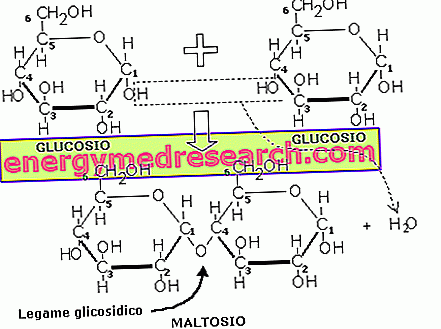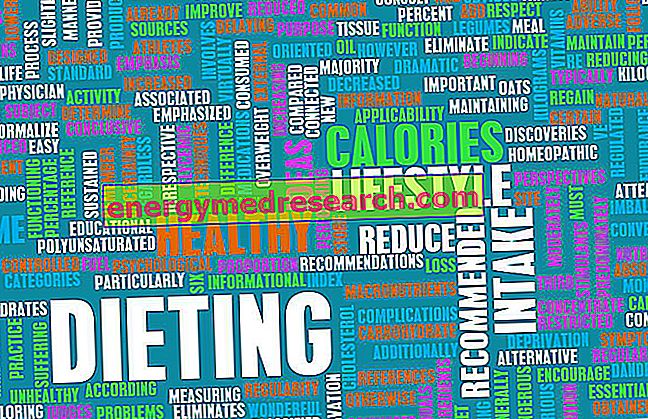Generality
What are disaccharides?
The disaccharides, or diolosides, are carbohydrates formed by the union of two simple sugars, in turn defined monosaccharides.
DISACCARIDE = MONOSACCARIDE + MONOSACCARIDE
Plant and animal disaccharides

Maltose is composed of two glucose molecules and generally derives from the partial hydrolysis of longer complex starch chains.
In the milk of each mammal we find lactose, a sugar formed by the union of glucose and galactose.
All these substances belong to the category of disaccharides, but they can be called, more generally, sugars or simple carbohydrates. Saccharose, in particular, is nothing but the kitchen sugar of the common language and is particularly abundant in sugar cane and beet.
| The most common disaccharides | |||
disaccharide | Unit 1 | Unit 2 | Bond |
Sucrose | α D Glucose | β D Fructose | α (1 → 2) |
lactulose | β D Galactose | β D Fructose | β (1 → 4) |
Lactose | β D Galactose | α D Glucose | β (1 → 4) |
Maltose | α D Glucose | α D Glucose | α (1 → 4) |
Trehalose | α D Glucose | α D Glucose | α (1 → 1) α |
cellobiose | β D Glucose | β D Glucose | β (1 → 4) |
Features
Physico-chemical properties of disaccharides
Like the monosaccharides that constitute them, disaccharides are generally solubilized in water and have a sweet taste.
The bond that holds the two monomers together is called the glycosidic bond and involves the anomeric carbon of a monosaccharide and an alcoholic group of the other, with the elimination of a water molecule. Depending on whether it affects the anhomeric OH in the alpha or beta position, this bond is called alpha or beta glycosidic. Position alpha means that the hydroxyl group bound to C1 is located in an axial position, ie below the plane identified by the structure of the molecule, while position β indicates that it is located above the plane of the ring (in an equatorial position).
Classification
How can disaccharides be classified?
On the base of:
- Availability: in this article we are dealing only with the available disaccharides, that is the digestible ones, but there are other disaccharides from which the human organism is not able to obtain energy and which, if introduced with the diet, mainly act as prebiotic molecules.
- Food origin: animal or vegetable.
- Type of monosaccharides that compose them: combinations of glucose, fructose and galactose.
- Chemical bonds: alpha or beta glycosidic, in position 2, 4 or 6, which determines their availability and many chemical-physical characteristics.
- Reducing and non-reducing potential: depending on whether the glycosidic bond affects only one or both the anomeric OH (the C1 carbon atom is called anomeric carbon).
Reducing and non-reducing disaccharides
Maltose
The maltose, shown in the figure, consists of the union of two glucose molecules, held together by a α 1-4 bond; it is a reducing disaccharide, as the bond only affects an anomeric OH (that of glucose, which is found under the molecular plane and is therefore of the alpha type).

Sucrose
The disaccharide sucrose is represented in the image below, consisting of the union of a glucose molecule with a fructose molecule; this time it is a non-reducing sugar, since the bond - of type 1-2 α, Β diglycosidic - affects both the anomeric OH (in fructose the anomeric carbon is C 2 ).

Lactose
Lower down, the two monosaccharides are shown, glucose and galactose, which together with a Β 1-4 bond give rise to lactose, a reducing sugar.

Digestion
How does the digestion of disaccharides occur?
The glycosidic bond can be separated by hydrolysis with diluted acids or by specific enzymes. The latter are found at the level of the intestinal mucosa, particularly in the brush border.
The most famous, since its absence leads to an annoying intolerance to milk and dairy products, is called lactase. As the name suggests, this enzyme is entrusted with the digestion of lactose, which is broken down into the two monosaccharides that constitute it, glucose and galactose.
Another example is given by the enzyme saccharase, which hydrolyses disaccharides such as maltose and sucrose.
Sources
What are the dietary sources of disaccharides?
The food sources of disaccharides are mainly the following:
- Sources of lactose : animal milk, of any kind (with significant differences in percentages), and human. Lactose also remains in derivatives, in concentration inversely proportional to the possible fermentation of lactic bacteria; yogurt as well as fresh cheeses (stracchino, squacquerone, philadelphia etc.) contain little, but they can still be poorly tolerated by people suffering from a very significant intestinal deficiency of lactase. On the other hand, aged cheeses are safer because they are very low in lactose (such as Grana Padano and Parmigiano Reggiano). Lactose can be removed from milk by artificially adding the enzyme lactase and obtaining delactosate milk.
- Sucrose : among natural foods it is abundant only in honey and in certain saps, such as maple. On the other hand, the main sources of sucrose in the human diet are foods containing table sugar, derived from the processing of sugar beet and sugar cane.
- Maltose : it is rare in natural foods. It is often added, in synthetic form, in the recipes of baked products (bread and derivatives) or in desserts (cakes, etc.). It is formed in large quantities in the intestine during starch digestion.



